In this article, I’ll share our journey of sales enablement at IBM, how we focus on client-centricity, and how we fit to win and scale.
I’ll cover our guiding principles, our strategy, how important the role of the manager is in executing this strategy, and how we are evolving when it comes to skills and learning. I’ll finish by touching on the digital experience and power of gamification.
My name’s Mary Tafuri and I'm the VP, IBM Global Sales. What I want to share with you in this article is our journey of sales enablement in IBM, how we focus on client-centricity in what we do, and how we fit to win and scale, scale because of course, it's a large company.
Our ambition is to really have the best sales workforce in the market. What we do in every program has to have a tie between our clients and the value we bring to our clients.
When it comes to value, the most important thing we can think of is yes, of course, what we sell, but also how we sell, the skills of our sellers. We constantly focus on how we can lift up, open up, and step up, when it comes to skills and learning.
I'll be focusing on:
- Our guiding principles
- Accelerate 2021: Skills activation - client centricity
- Evolving skills activation
- Digital experience
Our clients are going through a significant challenge, especially with COVID-19, and our sellers of course have to deal with it. We want our sellers to be considered the trusted advisor for the clients.
They want to be a partner for innovation, a partner that can help clients to go through this challenging time, survive and thrive.
Our clients are going through a significant challenge, especially with COVID-19, and our sellers of course have to deal with it. We want our sellers to be considered the trusted advisor for the clients.
They want to be a partner for innovation, a partner that can help clients to go through this challenging time, survive and thrive.
Create space for innovation
If you want to have sellers that are innovative, you need to create space for innovation to happen. What shifts do we need to evolve from:
- Episodic,
- Top-down cascading learning,
- Overlapping curriculum,
- Inspection kind of behavior,
- Plan specific learning.
To a world where you have:
- Continuous learning,
- Curious learning,
- Space for self-initiated learning.
You can give some guidance and provide some assets but really, you want to be the catalyst for exponential learning.
Exponential learning
A platform holistically speaking, where they can, yes, learn from what you share, but also what others can share in the ecosystem around them. I'll unfold all of these things for you.
Our guiding principles
First, we are strong believers in design thinking in everything we do, of course also in sales enablement.
Design thinking
When I started this journey a couple of years ago, the first thing I wanted to do is engage our sellers.
Seller engagement
When I say sellers, I really mean any role in the go-to-market from the client executive to the digital sellers, to the brand rep, portfolio rep, or technical roles, architect, technical sellers, design consultants, or data scientists.
Reinvention by design
We have all these roles we constantly enable so we have multiple opportunities during the year to engage them in design thinking sessions to see how we can reinvent ourselves, how our programs are resonating with them, how they suggest we evolve so we can be more relevant for them.
Collaborative at the core
Most importantly, how we can measure an activation, how we can provide an opportunity for them to collaborate and learn from each other, how, as you are with them in this journey, you can scout talent, and how you can use those talents to really find ambassadors for what you're trying to deliver.
Delivered with confidence and quality
In those ambassadors, a special role is there for the first-line managers. The result of all of this journey is you have sellers that are more confident and deliver the high value and quality selling you want for your client.
On top of all of that, you want to have fun and I will come to this fun element as I go through this article. Let me share with you a little bit more in detail when we look at the enablement experience in one year, and what that looks like.
Accelerate 2021: Skills activation - client centricity
Fast Start
First, we start with Fast Start. Fast Start has been going on for a number of years now and every year we just do better, at least that's what the participants or the sellers tell us with the NPS and with all the unsolicited feedback we receive every year.
This really motivates us to do even better as we go because it's really rewarding to see them so engaged and learning and collaborating with others.
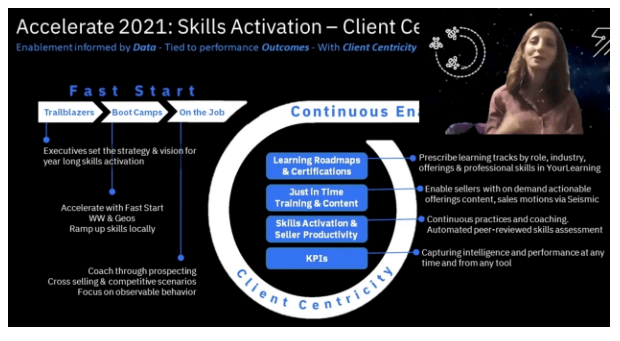
Trailblazers
We start with what we call trailblazers. Imagine this moment as when our top leadership is sharing the strategy of how we're going to win in the market, in the various business units, in the various geographies, and for the various roles. We have this moment of setting the vision and the plans.
Boot camps
Then we get into boot camps. Boot camps are about practicing, it's not a lecture, it's not University style, it's really getting in the small workgroups and practicing and providing feedback. We have them working in cohorts based on the roles they play, the offerings they have, the geography where they work, and so on and so forth.
We do allow cross-pollination because we do believe that's one of the most valuable ways to learn as well.
On the job
The week after, a month-long experience we call 'on the job' starts where we still engage with them, but really it's about putting in practice all the techniques they learned during the boot camp, to accelerate opportunities they have in work to identify new opportunities.
In fact, we have a special focus on the identification of new opportunities. With these challenges that we are going through with COVID-19 that is not allowing in-person, big events, those were the main source of lead generation, we have to be creative on how we can make the top of the funnel healthy again.
Opportunity identification and cross-pollination
This aspect of opportunity identification and cross-pollination is really very, very important. In unleashing this energy around cross-pollination, we really use a lot of use cases, and how we can help our sellers to think from one entry point, how they can expand, not in the same offering set, but in a different one.
So how can they grow to leverage other offerings and bring an augmented value to that client?
Learning roadmaps and certifications
As I'm walking you through all of this, you can see the client-centricity is at the heart, at the core, at the root of all we do. Yes, we do that at the beginning of the year and we constantly continue to deliver smaller types of learning experiences, learning roadmaps, opportunities for certification, or just in time learnings, always with a tie to the client.
We don't release any asset or any program if there is not a client value embedded into it.
KPIs
Of course, KPIs are very important, we are data-driven and we look at how we are making an impact with any of the programs we’re doing.
In fact, we ask the sellers to target the opportunities in our CRM with special codes that allow us to look at what is working, what problem is working better than others so we can perfect those and maybe cut those that are not so relevant.
Looking at the skills and how growing and investing in the skills is really impacting the bottom line is another strong KPI. We have a very solid line that shows for all the offerings we have, for all the roles that we have, how learning and advancing the skills truly impacts the productivity of the sellers.
This is very important because often sales enablement is considered a cost centre so you really need to be serious about showing the value you bring.
The role of the first-line managers
In all of this journey, a key element for success is really the manager, the role of the first-line manager. I always say, the managers are the backbone of the organization, no matter the size of the organization and no matter the type of business you do.
If you have a strong first-line manager in your organization playing that role, you can do magic in terms of engagement, productivity, and so on.
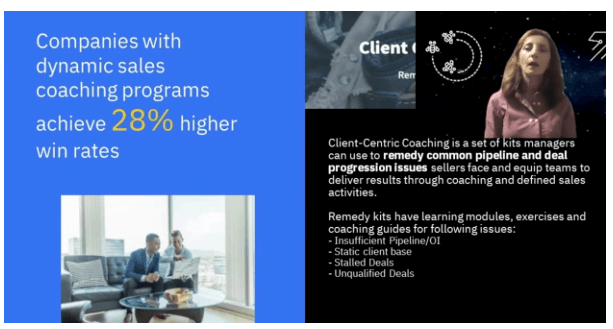
Deal coaching
When it comes to go-to-market, there is one specific deliverable or task the managers do that can truly make a huge difference. That's about deal coaching, as you see here 20% higher win rate can be achieved when deal coaching is done in the right way.
Empathic leadership
This is not about cadences, it's truly about being an empathic leader, a leader that can ask the right questions to your sellers and walk in their shoes and really understand the challenges they are facing.
Look together with them, side by side, virtually speaking on options they may have, so they can gain confidence and move forward.
What I wanted to share with you is what we have been doing specifically for managers. We launched something we call ‘coach for success’, and we've been delivering quite a lot of content for them.
We've been partnering with Colleen Stanley, in particular, for many months now and she has been helping us in the journey of emotional intelligence and how that helps in better connecting with clients and improving the relationship and business you do with them.
Client-centric coaching remedy kits for managers
More recently we did deliver another element, which I'm proud to share with you. It's called client-centric coaching remedy kits for managers.
What we decided to do is look at the client and the journey and the pervasive or recurring scenarios we can find and how we can help the managers with very specific concrete help if they are struggling with opportunity identification, because the pipeline is shrinking, or because the deals are stalled or maybe the deals are unqualified.
So we have very specific use cases and comp intel we've been sharing with them and it's digitally available for them anytime.
Coachable moments
A lot of that content is actually coming from what we call coachable moments shared by their peers.
We encourage crowdsourcing a lot and it has been amazing the participation we have received so far, a lot of them from all over the world willing to share their stories.
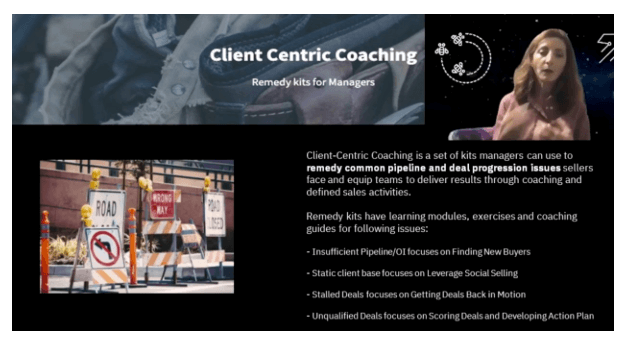
All these stories are stories that are actionable so on the one side, you want the other manager to resonate with what they’re hearing because another person like them is going through the same challenge, but then they want to walk away with something they can act on.
So far, it's going fantastic and is very well received.
Evolving skills activation
Switching gears around skills and here I’m talking about any role, not just the managers. What we have been doing in terms of evolution is something very interesting.
From micro to bold skills
We've been moving from a world where we were micromanaging and assessing the skills for each of the roles with hundreds of skill sets, to a world where we really want to focus on what matters.
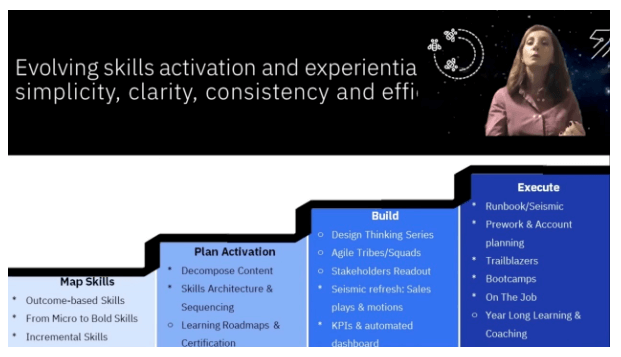
Outcome-based skills
What is an outcome-based skill, you might ask? It is a skill you need to have to accomplish what you need to accomplish in your role, what you are accountable for. There is a direct correlation between that skill and an outcome.
Some examples are:
‘Advise client on cloud’,
‘Engage the client in co-creation’, or
‘Leveraging design thinking’, and so on and so forth.
Of course, we go more into detail depending on the role they have. But this is very important because we are creating a space and environment, a culture where simplicity will drive clarity, consistency, and efficiency.
Plan activation
Starting with this foundation of limiting the number of skills to say 20, no more than that, more or less 20. Then define the learning roadmaps, specific to those roles and those skills for each role.
Really focus on module learning so if you look at all these roles, and all this skill map and you observe in the sequencing, which are the elements that are common across multiple roles?
Then you can codify the learning elements and create ones and instantiate in all the roles and all the learning journey where it makes sense.
As you see, we are very agile in the way we create learning experiences and content. Obviously, this is because we live in a world that's highly dynamic so it is important to deliver curated content. But most importantly, it is important to deliver something concrete and rooted in the client value and constantly evolving as the needs of the client evolve.
That's how we execute the fast start and the continuous learning.
Digital experience
Of course, in a normal world, we would invest quite a lot in in-person types of events. But as you know we are isolated, and we need to leverage the digital experience the best we can.
We've been investing a lot in evolving our digital experience and making sure we engage them in sharing their stories, like the examples I mentioned earlier with the managers and coachable moments.
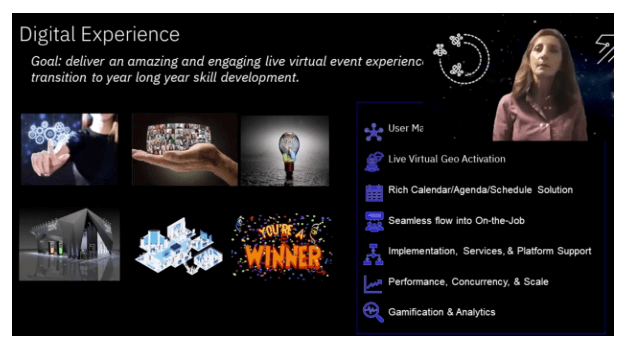
Share ideas, share digital assets like high-value demos, and so on, - encourage collaboration and reward the people that do so.
Gamification: IBM game on
This is the last nugget I want to share with you - our experience with gamification.
When I started this job, this was one of the first things I introduced because I saw in my previous world when I was working in the ecosystem with startups, universities, and business partners, a lot of innovation is driven via gamification.
All that engagement and fast learning happened that way.
Learning by playing
I don't know if you have kids, but I have two young kids now who are just learning by watching video games. Let's think about how that can be applied in the selling world.
Earn to learn
We started with a few games about how you can accelerate your time to learn, maybe a new offering or a new sales play. Then we added in other categories like challenging them to share high-value assets - essentially crowdsourcing.
Why? Because the enablement team, no matter how smart or experienced we may be, we are not touching the client every single day like other sellers and the tech team do.
Harvest high-value assets through gamification
In one of my previous jobs when I was traveling and meeting clients all around the world, I noticed the local team always had very powerful, high-value, tailored demos or whiteboards and other assets like that.
How can we harvest these treasures?
How can we reward the people that take the time to share?
Maybe by curating those assets so we can be high-value.
That's exactly what a gamification platform allows you to do.
You can see from the image, so far we have 126 games or challenges and more than 22,000 participants - a huge number. You can see the number of winners there.
Blue points are like blue dollars you can earn and purchase from a catalog a lot of different things from purses to watches, dinner for two, a small vacation, fitness gadgets, and so on and so forth. Many different things.
The power of a leaderboard
But really what made the difference in the adoption of the gamification was when we launched the leaderboard.
Sellers are very competitive so when you start to have them seeing who their peers are that may be excelling and advancing because they've been taking more time to share their win stories, whiteboards, or any other digital assets, they want to be on the top of the leaderboard.
That's how we saw that feature really made the difference. Now they are the ones going into our game to see what the next challenge is, how they can win more points and earn a higher position on the leaderboard.
I want to leave you with this reflection - gamification is very powerful and very flexible and much more than a way to drive the right behaviors when it is properly implemented.
We learned a lot through our journey, and I'm very happy to share that with you. Think about it, it can be implemented in many different ways and everybody can do it. You can start small and then grow if you see traction, but think about it. It's very powerful.
Thank you.


















 Follow us on LinkedIn
Follow us on LinkedIn



.svg?v=7919bee89c)